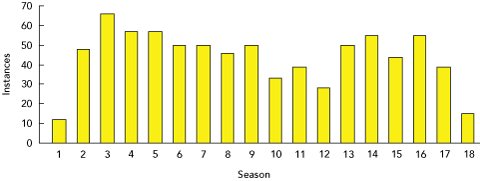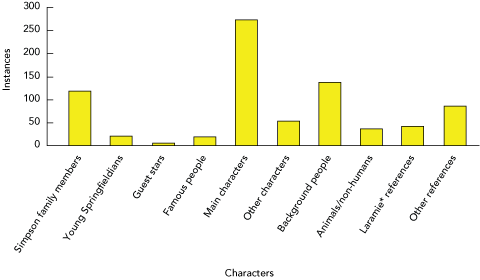The Simpsons has been an iconic animated television show since it first aired on 17 December 1989, after an initial run of sketches on the Tracey Ullman Show in 1987. After two decades and over 400 episodes, The Simpsons is the longest running situational comedy and has been rated as the most popular television show in history.1 It has reshaped American culture: with millions of individuals around the world who can identify characters, songs, and lines from the show, its influence cannot be overstated. The Simpson family consists of Homer (father), Marge (mother), Lisa (daughter), Bart (son) and Maggie (second daughter). They live in Springfield, a town somewhere in the United States. Homer works in the local nuclear power plant, Marge is a homemaker, Bart and Lisa attend Springfield Elementary School, and Maggie is a baby.
We included all 400 episodes in the first 18 seasons of The Simpsons (a season is 1 year of episodes, and there are about 22 episodes per season), which aired from 1989 until 2007. We recorded all instances of smoking (defined as any instance where smoking is mentioned or smoking was visible in any form) in these episodes. We used two methods for determining instances of smoking on the show: (i) we used the data on a public domain website2 that records all instances of smoking on The Simpsons television show (this website has been reported in previous studies3); and (ii) we watched the episodes and recorded instances of smoking on a standardised proforma. The correlation between the website data and our records was 0.96.
The show is currently airing its 20th season, and by the end of this year, there will be a total of 443 episodes. We chose to limit our investigation to the first 18 seasons of The Simpsons because this corresponds to what was reported on the public domain website during our study period (January to October 2008).2 We developed a database that incorporated all instances of smoking from the website and our own records.
We recorded 795 instances of smoking or references to smoking in 400 episodes over 18 seasons of The Simpsons (mean instances, 44 per season; range, 12–66 per season). More than half of these instances (498; 63%) involved male characters, while 156 (20%) involved female characters. Only 16 (2%) involved both sexes, and there were 125 instances of smoking (16%) that involved non-gender characters (eg, animals). In terms of age, we observed 607 instances of smoking by adult characters (76%), and 63 (8%) by child or adolescent characters; the remaining 125 (16%) did not fit either age group. Box 1 shows a bimodal distribution in the variation in instances of or references to smoking by season, with peaks in Season 3 (1991–1992) and again in Seasons 14 (2002–2003) and 16 (2004–2005). The main characters in the show had the highest frequency of smoking (Box 2), being involved in 34% of all instances of smoking. This was followed by background people (17%) and then the Simpson family members (15%). Young people of Springfield were shown smoking in only 3% of all smoking instances in the show.
There have been previous content-analysis studies assessing tobacco use and other health-related behaviours in television and the media that have included The Simpsons.3-5 A content analysis of New Zealand television in 2002–2004 reported that The Simpsons cartoon show had the highest number of characters smoking (average five per episode), compared with another 119 programs viewed as part of the analysis.4 In another content-analysis study, 63 episodes of The Simpsons (seven randomly selected from each of the first nine seasons) were watched to determine the types of health-related messages (HRMs) present in the show.3 The HRMs involved nutrition, smoking, alcohol, drug use, physical health, mental health, and others. This study found 129 instances (12% of all HRMs) associated with smoking (ranked third after nutrition and alcohol); of these, 104 were negative, 20 were neutral and 5 were positive. This difference may be the result of episodes being randomly selected or because of differences in the classification of the impact of each instance of smoking.
Previous studies have highlighted the influence of onscreen use of tobacco by movie stars on adolescents, and the increased likelihood of these adolescents taking up smoking.6 Moreover, other research has found that very young children (aged 3–6 years) see, understand and remember cigarette advertising,7 and the use of cartoon characters like Joe Camel by RJR Nabisco has been reported to be more effective in marketing cigarettes to children than to adults.8 A more recent study has suggested that children who watch a lot of television are more likely to start smoking at a younger age.9 Indeed, the consensus appears to indicate that there is a causal relationship between exposure to movie and television depictions of smoking and the initiation of smoking among children and adolescents.10 If this is true, children and adolescents who watch The Simpsons and observe the characters who smoke cigarettes may be influenced to take up smoking, despite more instances of smoking being reflected in a negative way (35%) or neutral way (63%) than a positive way (2%). Just being exposed to The Simpsons characters smoking in so many episodes may prompt children to consider smoking at an early age.
- Guy D Eslick1,2
- Marielle G Eslick3
- 1 Department of Epidemiology, Harvard School of Public Health, Boston, Mass, USA.
- 2 School of Public Health, University of Sydney, Sydney, NSW.
- 3 Boston, Mass, USA.
None identified.
- 1. Leopold T. A milestone for “The Simpsons”. CNN.com/Entertainment. http://www.cnn.com/2003/SHOWBIZ/TV/02/13/simpsons.300/index.html (accessed Mar 2009).
- 2. Jackson S, Lee H. The Simpsons vs smoking. The Simpsons archive. http://www.snpp.com/guides/smoking.simpsons.html (accessed Jan 2009).
- 3. Byrd-Bredbenner C. An internationally shared health frame of reference created by a television program: The Simpsons, a content analysis of health messages. Health Educ 2004; 104: 18-24.
- 4. McGee R, Ketchel J. Tobacco imagery on New Zealand television 2002–2004. Tob Control 2006; 15: 412-414.
- 5. Watson NA, Clarkson JP, Donovan RJ, Giles-Corti B. Filthy or fashionable? Young people’s perceptions of smoking in the media. Health Educ Res 2003; 18: 554-567.
- 6. Tickle JJ, Sargent JD, Dalton MA, et al. Favourite movie stars, their tobacco use in contemporary movies, and its association with adolescent smoking. Tob Control 2001; 10: 16-22.
- 7. Fischer PM, Schwartz MP, Richards JE Jr, et al. Brand logo recognition by children aged 3 to 6 years. Mickey Mouse and Old Joe the camel. JAMA 1991; 266: 3145-3148.
- 8. DiFranza JR, Richards JW, Paulman PM, et al. RJR Nabisco’s cartoon camel promotes Camel cigarettes to children. JAMA 1991; 266: 3149-3153.
- 9. Gutschoven K, Van den Bulck J. Television viewing and age at smoking initiation: does a relationship exist between higher levels of television viewing and earlier onset of smoking? Nicotine Tob Res 2005; 7: 381-385.
- 10. National Cancer Institute. The role of the media in promoting and reducing tobacco use. Tobacco Control Monograph No. 19. Bethesda, Md: US Department of Health and Human Services, National Institutes of Health, National Cancer Institute, June 2008. (NIH Pub. No. 07-6242.)







Abstract
Objective: To determine the frequency of smoking on The Simpsons television show, and the relationship with the sex and age groups of characters shown smoking, and with positive, negative and neutral connotations associated with instances of smoking.
Design and setting: Content analysis (performed from January to October 2008) of instances of smoking that appeared in the first 18 seasons of The Simpsons television show, which aired from 1989 to 2007.
Main outcome measures: Frequency, impact (positive, negative, neutral) of instances of smoking; and frequency associated with age (child or adolescent versus adult characters), sex and types of characters on the show.
Results: There were 795 instances of smoking in the 400 episodes observed. Most (498; 63%) involved male characters. Only 8% of instances of smoking (63) involved child or adolescent characters. Just over a third of instances of smoking (275; 35%) reflected smoking in a negative way, compared with the majority, which reflected smoking in a neutral way (504; 63%) and the minority, which reflected smoking in a positive way (16; 2%). Child and adolescent characters were much more likely to be involved in instances of smoking reflected in a negative way compared with adult characters (odds ratio, 44.93; 95% CI, 16.15–172.18).
Conclusions: There are a large number of instances of smoking in The Simpsons television show. Child and adolescent characters are much more likely to be portrayed in instances of smoking reflected in a negative way than adult characters. Viewing The Simpsons characters smoking may prompt children to consider smoking at an early age.